How to grow dahlias from seed
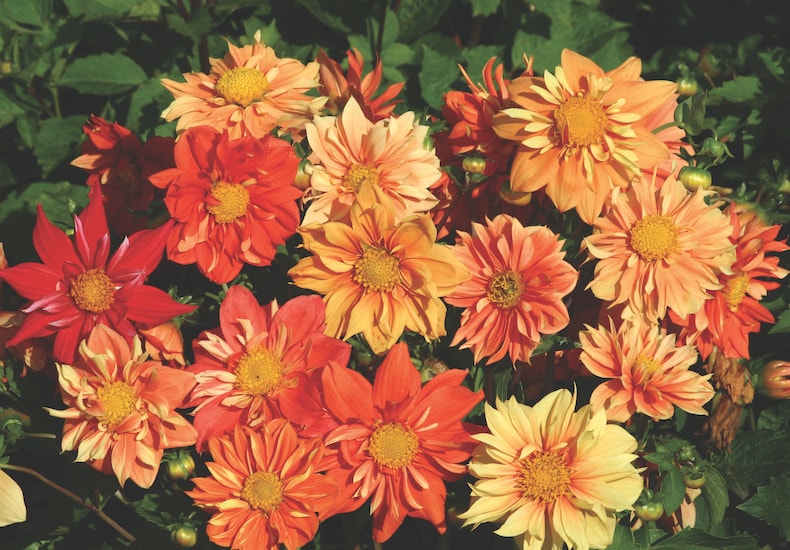
Grow dwarf dahlias in beds and borders
Image: Dahlia variabilis 'Sunny Reggae' from Thompson & Morgan
The bright flamboyance of the dahlia is something that gardeners either love or hate, and the dinner-plate-sized blooms seen in shows excite some of the most controversy. Some won't grow anything else, while others won't grow them at all! For those that enjoy these fabulous flowers, an increasing number of dahlias are available to grow from seed. Here, Graham Rice recommends the best varieties to try and shares some simple techniques to help you succeed.
Browse our range of dahlias seeds for more inspiration.
Best dahlia varieties to grow from seeds
Show varieties are raised from cuttings, but feelings are much less intense about the bedding dahlias which are raised from seed. Of course even the most prized show varieties, or at least those that have not arisen as sports, must be raised from seed at some stage following hybridisation. But for most gardeners, raising dahlias from seed concerns bedding varieties and varieties for cut flowers. No seed-raised strains have consistently reached the standard required for success at shows. It's in the small bedding types that seed raised dahlias really come into their own.
Where do dahlias come from?
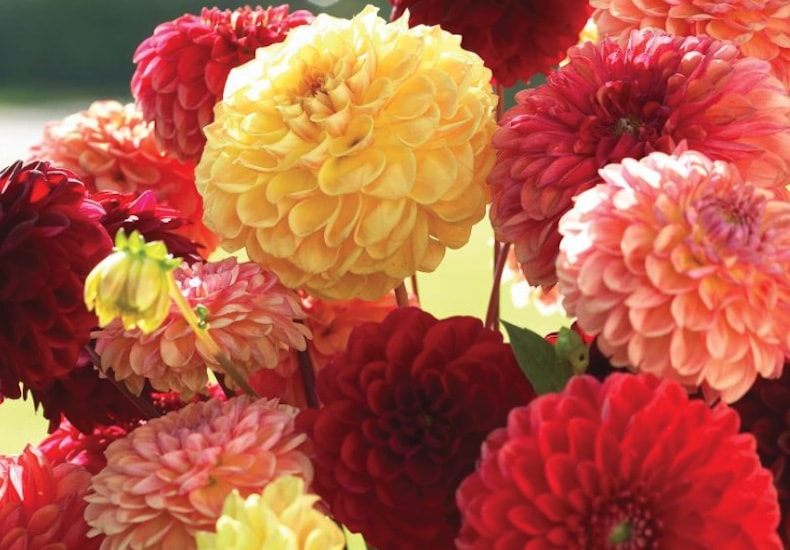
'Pompone Mixed' provides height and structure to the back of borders
Image: Dahlia variabilis 'Pompone Mixed' from Thompson & Morgan (© Visions BV, Netherlands)
The dahlia originates in Mexico, Colombia and Guatemala where it grows in the high plains, usually in a well drained soil, although the heavy rainfall of the area ensures that the plants are never short of water. Originally the plant was thought to grow in subtropical conditions but, growing as it does above 3,000ft, although there is rarely a frost, growing conditions are quite cool.
It was first noted by botanists in the sixteenth century and was cultivated by early settlers and it is thought that the first three species introduced from Mexico were probably hybrids. The first plants arrived in Madrid in 1798 but they were soon lost as they were grown in conditions which were far too warm. In the early years of the nineteenth century, plants were introduced again and, as the cultivation became better understood, were grown more and more widely.
The first three introduced were:
- Dahlia coccinea - a single red
- D. rosea - a single pink
- D. pinnata - a semi-double purple
A fully double variety was raised in 1815, and the introduction of Dahlia juarezzii in 1876 with its long narrow petals with recurved margins led to the development of cactus dahlias. By the 1830s there were literally hundreds of varieties available. The National Dahlia Society was founded in Britain in 1881 and varieties are still appearing constantly.
In 1922 the first successful bedding dahlia was introduced 'Coltness Gem', and a mixture of colours under this name is still available. Seed collected from tall show varieties has been available for many years but tends to yield largely unsatisfactory results. Although the individual flowers are often perfectly adequate for cutting for the house, the number of flowers produced compares very unfavourably with vegetatively propagated varieties.
How to sow dahlia seeds
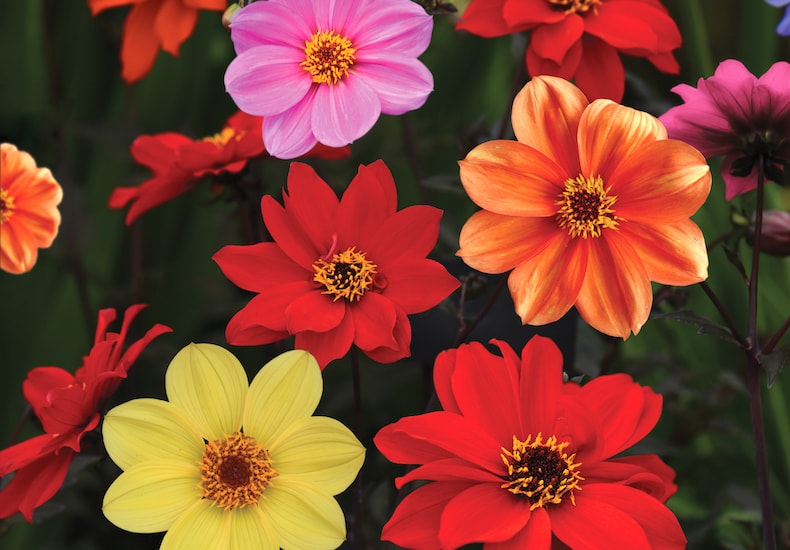
'Bishop's Children' provides a fiery mix of striking colour
Image: Dahlia variabilis 'Bishop's Children' from Thompson & Morgan
Plant Heritage (formerly the NCCPG) feels that these plants are in danger of disappearing from cultivation and deserve to be grown much more. Raising dahlias from seed is not a difficult business although they do need a fairly high temperature for germination followed by frost protection until planting out. I have discovered a couple of other ways of raising them, which I will go into later, but the basic routine is as follows:
Seed is best sown in spring and given a germination temperature of about 65F (18C). I have tried three ways of treating them. The seeds are quite large so in each case they can be sown individually ensuring they are not too crowded. The three alternatives for raising them as half-hardy annuals are as follows:
- Sow in a seed pot or seed tray and prick out into a seed box (flat). It may be necessary to pot the seedlings up if they get too crowded in the seed box.
- Sow in a seed pot or seed tray and prick out into individual pots.
- Sow in cell packs or other small containers and pot up into individual pots.
Personally I've found the second method to be the most convenient. It's best to sow in a 5in (7.5cm) half pot as the roots tend to develop quickly. If the seeds are spaced about 1 inch (2.5cm) apart they can be left until the leaves touch before being potted up.
The type of compost is not crucial. A soil-less compost works well as long as there is some drainage, like perlite or sharp sand added. John Innes Seed Compost is also perfectly satisfactory. After sowing the seed and spacing it out, cover the seed with sifted compost to a depth of about 3mm. It is important that the compost be moist, though not sodden, before the pot is filled and that the compost sifted over the seed is also moist. A light watering from a can with a fine rose is then all that's needed.
The seed pot should go in a propagator at a temperature of 65F (18C). No covering is required save the lid of the propagator and any shading material necessary to prevent overheating.
Germination will usually be fairly rapid, 10-14 days, quicker if the temperature is higher. When the leaves of the seedlings touch they can be potted up. Most of the seed will germinate together so the compost can be removed from the pot and broken up for the seedlings to be removed. The root system may be well developed by potting time so the seedlings must be handled with care.
Growing on dahlia seedlings
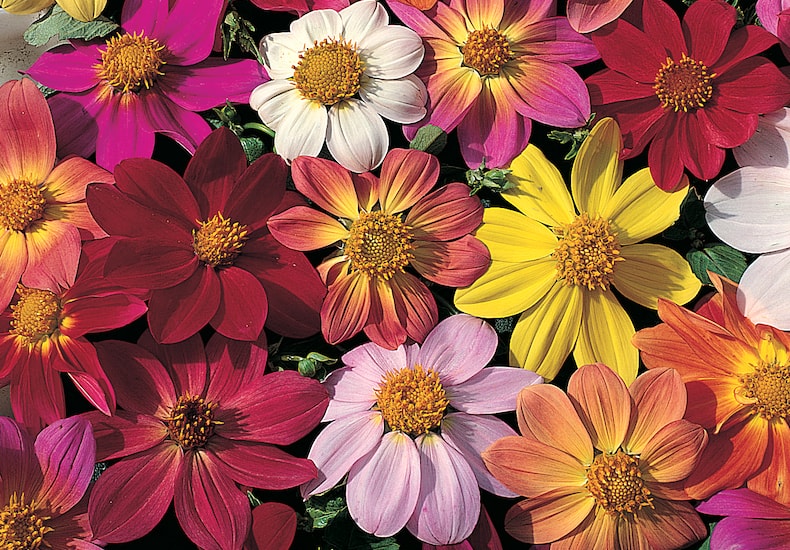
This vibrant mixture of delicate single flowers reach up to 150cm tall
Image: Dahlia coccinea 'Species Mixed' seeds from Thompson & Morgan
Young plants can be grown in a relatively cool temperature once established in their pots. 45F (7C) is the absolute minimum and the higher the temperature the quicker the seedlings will develop. If a minimum of more than 55F (13C) is maintained, the plants may develop more quickly than is wise and become tall and drawn. If temperatures are likely to be high, sowing should be delayed.
The plants should not be planted in the garden before the last frost. For about three weeks before planting time the plants should be hardened off in a well ventilated cold greenhouse or a cold frame to accustom them to life outdoors.
Flowers may well be in evidence at planting time but, if not, will soon appear and then continue until the first autumn frosts.
Raising dahlia seeds in a cold greenhouse
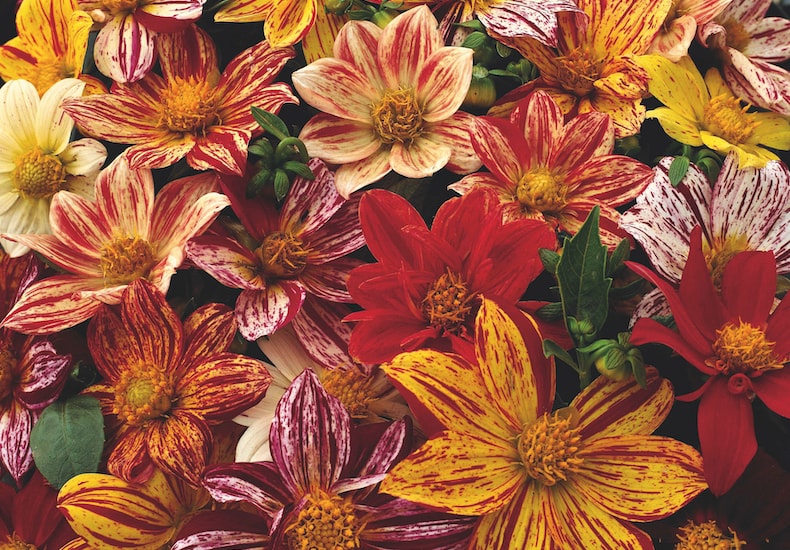
From the easy grow range, these compact plants have unique striped blooms
Image: Dahlia variabilis 'Fireworks Mixed' seeds from Thompson & Morgan
Dahlias can also be raised in a cold greenhouse with a propagator. I have sown seed as described above in a cold greenhouse in spring (early April in the UK) and potted the seedlings about six weeks later. After a further month they were planted outside and came into flower on small plants about a month after those sown with warmth. A well-drained compost is especially important if you're following this method. It's also important to use dwarf early flowering varieties such as 'Figaro' and 'Rigoletto'.
Direct sowing dahlia seeds
Finally, both these varieties ('Figaro' and 'Rigoletto') can also be sown outside like hardy annuals. Delay sowing until about a week or two before the date of the last frost and make sure the plants do not go short of water. Flowers should appear about 10 weeks after sowing, when the plants are still quite small, depending on the weather.
How to care for dahlias
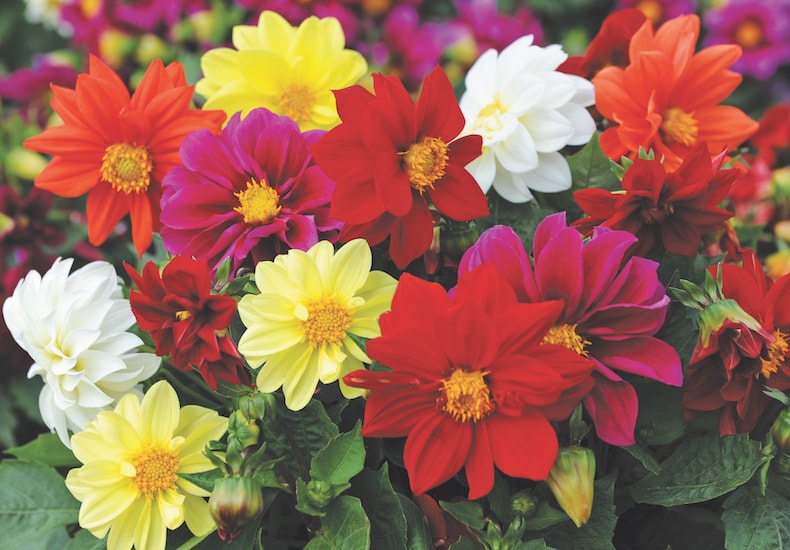
'Dwarf Mixed' makes a memorable main bedding display
Image: Dahlia variabilis 'Dwarf Mixed' seeds from Thompson & Morgan
In the garden, bedding dahlias thrive in a sunny site which does not dry out too much. Ensure that they are watered well after planting and that they don't dry out during the summer. The smallest varieties are excellent in tubs and window boxes and slightly taller ones will also provide flowers for the house.
Deadheading is vital right through the season and the seed heads can simply be pulled off the stems with a sharp tug - there is no need to cut them off individually. Liquid feeding is useful, especially for plants grown in containers. The only pest is likely to be blackfly, and an insecticide containing pyrimor is the safest spray.
Dahlia seeds to try at home
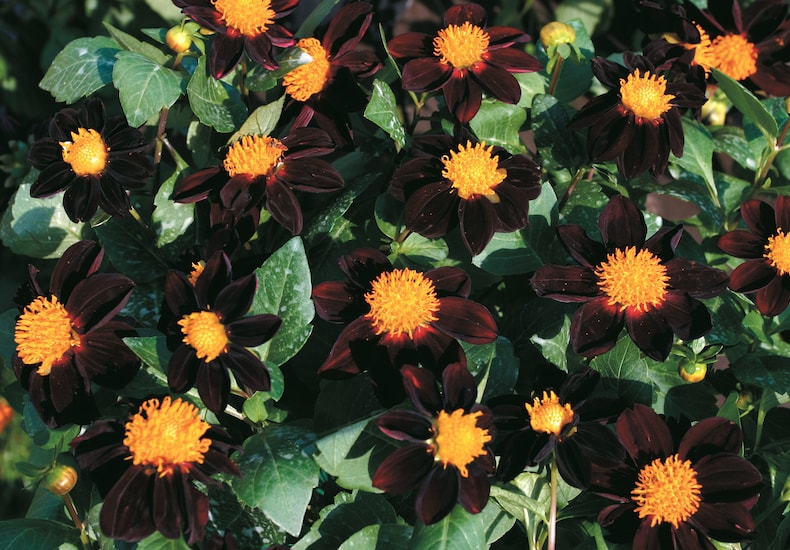
With luxurious velvety blooms, 'Black Beauty' is a short variety for the front of borders
Image: Dahlia 'Black Beauty' seeds from Thompson & Morgan
The varieties listed are all mixtures, but of course if there’s a particular colour in a mixture that takes your fancy, the tuber can be lifted and dried off, as vegetatively propagated varieties are saved for the following year. Varieties range in height from 10-24in (25-60cm) with single, double or collarette flowers and one variety even has purple foliage.
- Coltness Mixed 24in (60cm). Clear, bright, single flowers in a very wide range of colours.
- Dandy 24in (60cm). Flowers of collarette form (with a ring of small petals around the central disc) about 3in (7.5cm) across in a wide colour range. This variety did deteriorate a few years ago but has now been restored to its earlier glory.
- 'Figaro' 12in (30cm). Mostly double flowers on bushy plants in a wide range of colours. Unlike some dwarf varieties all the colours come on plants of about the same size. Good colour range. Sometimes known as 'Amore' or 'Rigoletto Improved'.
- Mignon 12in (30cm). A very dwarf single flowered mixture in many colours, starting to flower at about 6in (15cm). Very pretty and also known as 'Dwarf Dahl-face'.
- 'Redskin' 24in (60cm). Dull, bronze foliage distinguishes this variety from all others.
- 'Rigoletto' 15in (38cm). Being superseded by the dwarfer 'Figaro', which is sometimes listed as 'Rigoletto Improved'. It contains a slightly higher proportion of semi-double rather than double flowers but is excellent value.
- Sunburst 24in (60cm). Similar to 'Coltness Mixed' but with noticeably larger flowers and a wider range of bright and pastel colours.
Find plenty more dahlia growing advice and variety recommendations over at our dahlias hub page.
Author:
Graham Rice is editor of Growing From Seed magazine and author of a Handbook of Annuals and Bedding Plants.
Source of article
Growing From Seed - Autumn 1987 Vol. 1 Number 4
© The Seed Raising Journal from Thompson & Morgan
Sign Up For Exclusive Special Offers




© 2025 Thompson & Morgan. All rights reserved. A division of Branded Garden Products Limited.



